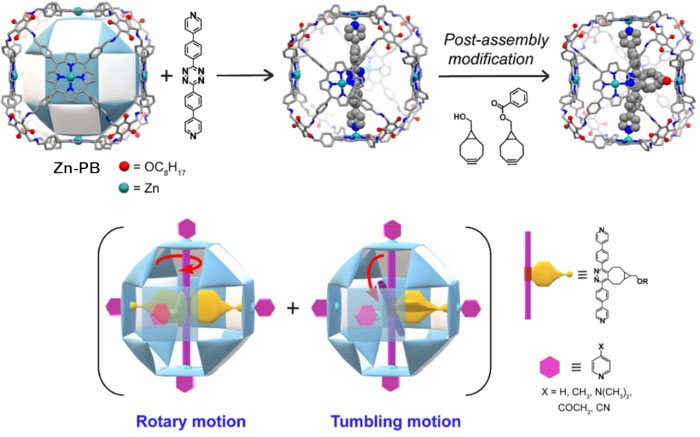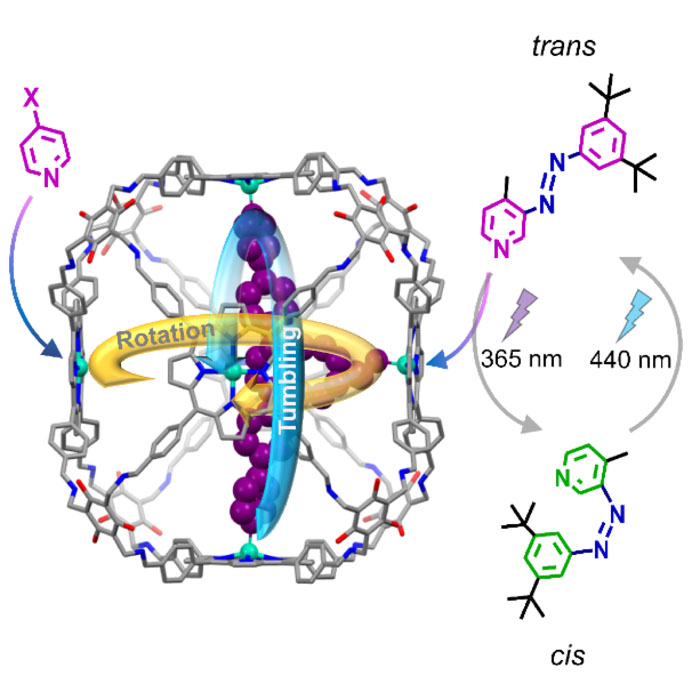| Jan 18, 2022 |
Boxing up molecular machines
(Nanowerk News) Machines that are confined inside a cage or casing exhibit interesting properties by converting input energy into programmed functions. One such system is the mechanical gyroscope or gyrotop, a fascinating toy that amuses everyone with its incessant rotation.
|
|
Gyroscopes also have practical applications in the internal navigation systems used in airplanes and satellites, virtual reality headsets, and wireless computer pointing devices.
|
|
What makes these gyroscopes so beneficial is not only the rotor part but also the frame that aligns the rotor in a particular direction, which restores the momentum of the rotor and protects it against obstacles.
|
|
In addition, everyday machines like table fans or electric pumps also enclose rotors inside cage-like frameworks to isolate them from the outside environment. At the molecular level, the biological machines that are present in every living thing also operate within the confinement of cells and exhibit precise and programmed motions and actions. These machines are controlled remotely by external stimuli. Synthesizing such complex design and functions in an artificial molecular system is very challenging.
|
|
Now, a team led by Director KIM Kimoon at the Center for Self-assembly and Complexity within the Institute for Basic Science in Pohang, South Korea successfully constructed a remotely controllable supramolecular rotor inside a hollow cube-shaped zinc(II)-metallated porphyrinic cage (Zn-PB) molecule.
|
 |
| Design, synthesis, and functioning of the rotor within Zn-PB. (Image: Institute for Basic Science)
|
|
In general, the direct installation of a rotor inside molecular cages can be very challenging due to the limited size of the cage windows. Therefore, researchers followed bottom-up strategies to prepare these rotor-containing cages.
|
|
In order to circumvent these challenges, Kim and colleagues devised a new strategy in which a linear axle was first inserted inside Zn-PB and then modified with a sidearm to construct a rotor. |
|
While the rotor alone shows no motion, the addition of a chemical stimulant initiates both rotary motion (rotation of the rotor arm around the axle) and tumbling motion (rotation of the axle) with rotation speeds of 4000 Hz and 1 Hz, respectively.
|
|
“We hypothesized that by using a catalyst-free and facile inverse electron demand Diels-Alder (IEDDA) reaction, we can easily append different functionalities with the axle without harming the cage. Furthermore, by choosing a suitable arm for the brake, a controlled rotor can be designed that can be started or stopped by external stimuli,” explains Avinash Dhamija, the first author of this study (Chem, "Remotely Controllable Supramolecular Rotor Mounted inside a Porphyrinic Cage").
|
 |
| Remotely controlled rotation and tumbling motion of the rotor in the presence of chemical stimulants and a photo-responsive molecule. (Image: Institute for Basic Science)
|
|
Previously, the same group has constructed 3D superstructures by connecting Zn-PBs through bridging ligands and fullerenes from outside the box cavity. These results inspired them to venture a step further to explore the inner cavity of Zn-PB. Zn-PB has 6 Zn coordination sites that can capture multidentate molecules inside the structure. A bidentate linear axle was therefore fixed inside the cage and then post-assembly modification was performed to construct a controllable rotor.
|
|
The authors also designed a pyridine-based photoresponsive molecule that can connect and disconnect with Zn-PB when exposed to UV and visible light, respectively. This allows reversible control of the dual mechanical motions of the rotor. Controlling the rotor in this way is like a game of tug-of-war - pyridine derivatives pull the Zn centers from outside the cavity and break the internal rotor connections, which initiate both 90° jump like rotary and tumbling motions in a stochastic manner.
|
|
The present concept of confining molecular machines inside a molecular cage and remotely controlling their functions will be beneficial for understanding the operation of natural molecular machinery as well as for the development of smart and tunable molecular devices.
|


